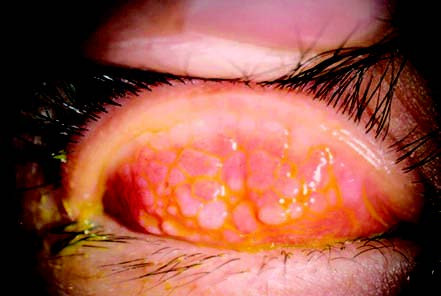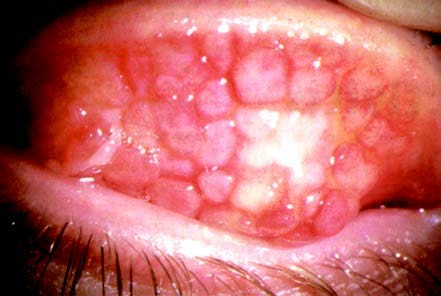Allergic conjunctivitis refers to a group of diseases caused by hypersensitivity reactions of the conjunctiva to allergens, predominantly mediated by type I and type IV hypersensitivity. Based on pathogenesis and clinical presentation, it is classified into five subtypes: seasonal allergic conjunctivitis (SAC), perennial allergic conjunctivitis (PAC), vernal keratoconjunctivitis (VKC), giant papillary conjunctivitis (GPC), and atopic keratoconjunctivitis (AKC).
Etiology
SAC and PAC are primarily associated with type I hypersensitivity reactions and exhibit minimal to no proliferative changes in the conjunctiva and inflammatory cells. These two subtypes are the most common forms of allergic conjunctivitis observed in clinical practice. VKC, GPC, and AKC involve both type I and type IV hypersensitivity reactions, with proliferative lesions of the conjunctiva and inflammatory cells being more common. VKC is characterized by papillary hyperplasia of the tarsal conjunctiva and/or gelatinous hyperplasia at the limbus, frequently involving the cornea. GPC is an inflammatory proliferative condition of the tarsal conjunctiva caused by mechanical irritation, primarily affecting the upper eyelid; common irritants include contact lenses and surgical sutures. AKC is a chronic allergic conjunctivitis associated with atopic dermatitis of the face. Although papillary lesions may be seen in some patients, most cases lack proliferative changes in the conjunctiva or inflammatory cells.
Clinical Manifestations
Allergic conjunctivitis typically presents with eye itching, a foreign body sensation, and increased conjunctival discharge. Eye itching is the primary complaint for most patients, though some report a foreign body sensation. Discharge in the conjunctival sac is generally whitish and mucous in nature. Children may manifest symptoms such as eye rubbing or frequent blinking. Conjunctival hyperemia is the most common sign, often accompanied by varying degrees of conjunctival edema. Conjunctival papillae represent a characteristic finding in allergic conjunctivitis. Overall, SAC and PAC predominantly present with conjunctival hyperemia and edema, often without conjunctival papillae. In contrast, VKC, GPC, and AKC are typically associated with the presence of conjunctival papillae, with frequent involvement of the cornea.
Seasonal Allergic Conjunctivitis (SAC)
In addition to the common symptoms and signs of allergic conjunctivitis, this condition has a distinct seasonal pattern. Eye itching is the most prominent symptom. More than 60% of patients also experience allergic rhinitis due to sensitization to pollen allergens.
Perennial Allergic Conjunctivitis (PAC)
This subtype is primarily triggered by dust mites. Some patients experience mild symptoms and lack specific clinical features, particularly older adults, making definitive diagnosis challenging. Eosinophil detection rates in conjunctival impression cytology are generally low.
Vernal Keratoconjunctivitis (VKC)
This condition is characterized by conjunctival papillae, primarily affecting the upper tarsal conjunctiva. Clinically, it may be classified into conjunctival (dominated by conjunctival papillae), limbal (characterized by limbal Horner-Trantas dots), and mixed types (involving both conjunctiva and limbus). Severe cases may develop shield ulcers of the cornea. The primary allergens include dust mites, with some patients also reacting to pollen or animal dander. In many cases, an allergic trigger cannot be identified. VKC is often associated with genetic predisposition.

Figure 1 Palpebral type of vernal keratoconjunctivitis
The tarsal conjunctiva exhibits cobblestone-like giant papillae.
Giant Papillary Conjunctivitis (GPC)
The main clinical feature is conjunctival papillae with a diameter greater than 1 mm. This condition is frequently associated with irritants such as contact lenses, ocular prostheses, or conjunctival sutures.

Figure 2 Giant papillary conjunctivitis
The upper tarsal conjunctiva shows papillary hypertrophy with a diameter greater than 1 mm, resembling a mushroom-like appearance.
Atopic Keratoconjunctivitis (AKC)
In addition to typical features of allergic conjunctivitis, the primary hallmark of this condition is associated atopic dermatitis on the face. In severe, long-standing cases, complications such as symblepharon and conjunctival fornix scarring may occur.
Diagnosis
The clinical diagnosis of allergic conjunctivitis requires the presence of both symptoms and signs. Symptoms include eye itching, possibly accompanied by a foreign body sensation and increased conjunctival discharge. Signs include conjunctival hyperemia, conjunctival papillae, and at least one specific corneal finding. Laboratory tests, such as conjunctival scrapings demonstrating eosinophils, provide further confirmation of the diagnosis.
Differential Diagnosis
Conditions requiring differentiation from allergic conjunctivitis include infectious conjunctivitis, drug-induced toxic conjunctivitis, autoimmune keratoconjunctivitis, and dry eye disease. Certain lacrimal duct disorders, such as partial nasolacrimal obstruction or canaliculitis, can also mimic allergic conjunctivitis. A detailed medical history is critical for diagnosis and differentiation, including information on systemic allergic diseases, family history of allergies, environmental factors, use of contact lenses, and history of ocular surgery.
Treatment
The treatment principles for allergic conjunctivitis include health education, avoidance of allergens, and alleviation of symptoms and signs. For most patients, the goal is to relieve discomfort such as itching and redness. For patients with chronic or recurrent symptoms, the focus is on controlling inflammatory responses.
Avoidance of Allergens and Health Education
Minimizing or avoiding exposure to allergens and improving living environments can help alleviate and control the condition. For patients with dust mite allergies, ensuring thorough indoor cleaning and mite removal is beneficial. Those with pollen allergies may benefit from protective measures during pollen season. In areas with severe air pollution, reducing outdoor activity can be helpful. Gentle eye cleaning and cool compresses may provide some relief from itching and discomfort.
Pharmacological Treatment
Antihistamines
Local antihistamine eye drops are effective for treating mild to moderate allergic conjunctivitis. For severe or frequent episodes, combining with oral antihistamines is an option, though their effect is slower and less effective for actively symptomatic allergic conjunctivitis. Oral antihistamines can aggravate symptoms in dry eye patients, potentially worsening discomfort, which necessitates caution. Antihistamines should be used with caution in patients with angle-closure glaucoma.
Mast Cell Stabilizers
Commonly used agents include sodium cromoglycate and nedocromil. These work best when administered prior to allergen exposure, but are less effective in treating established symptoms. Prophylactic use during high-risk seasons, with 4–5 daily applications, is often recommended to prevent outbreaks or maintain treatment efficacy.
Dual-action Antihistamines and Mast Cell Stabilizers
These drugs combine antihistamine effects with mast cell membrane stabilization and represent the first-line treatment for allergic conjunctivitis.
Corticosteroids
Local corticosteroid eye drops effectively suppress activation of various immune cells and release of inflammatory mediators. Short-term use is indicated for severe or recurrent cases to avoid complications such as cataracts, glaucoma, fungal infections, and delayed corneal epithelial healing.
Immunosuppressants
Agents such as cyclosporine and tacrolimus, administered as local eye drops, inhibit multiple inflammatory mediators and suppress mast-cell and T-cell-mediated allergic conjunctival inflammation. These drugs are an option for severe allergic conjunctivitis, particularly in patients who do not tolerate corticosteroids.
Other Medications
Artificial tears dilute allergens in the conjunctival sac, lubricate the ocular surface, and alleviate symptoms. Vasoconstrictor eye drops reduce blood vessel dilation, capillary permeability, and symptoms such as redness, swelling, and increased discharge but do not suppress inflammation or relieve itching. Routine use of vasoconstrictors is not recommended. Non-steroidal anti-inflammatory drug (NSAID) eye drops may inhibit prostaglandin production in type I hypersensitivity reactions. These are suitable for mild cases of seasonal allergic conjunctivitis but have limited efficacy for acute allergic conjunctivitis.